The Best and Worst Commodity Performers of 2007 and Outlook for 2008
Commodities / Resources Investing Dec 26, 2007 - 08:34 PM GMTBy: George_Kleinman
 The S&P 500 began 2007 at 1,428. On Friday, Dec. 21, it closed at 1,498 for a respectable, if unexciting, 4.9 percent return for the year.
The S&P 500 began 2007 at 1,428. On Friday, Dec. 21, it closed at 1,498 for a respectable, if unexciting, 4.9 percent return for the year.
Were there better places to be over this past year? You bet.
When trading futures, we use leverage. In many cases, all that's required is a 5 percent margin deposit of a contract's value. Under this scenario, just a 5 percent raw price move results in a 100 percent return on the initial margin deposit.
There have been days this year where various commodities have moved 5 percent in just one day. However, leverage is a double-edged sword, and the downs can be equally as dramatic as the ups, placing commodity futures in the high-risk category.
What if you remove leverage from the equation, putting the entire value of the contract up front as most people do when trading stocks? Looking at it this way, over the past year there have still been some fairly impressive moves in many commodities. However, not all commodities are created equal, and certain commodities lost value during 2007.
Top Commodity Performers (in descending order)
No. 4--Gold
- Close on 12/29/06= $674 an ounce*
- Close on12/21/07= $815 an ounce
- Percent change in 2007= 21percent
*Prices based on the February futures contract
In just the past few weeks, the US Federal Reserve pumped $40 billion of new liquidity into the financial system. This action should have trashed the US dollar, but the greenback actually strengthened.
Why? Not to be undone, the European Central Bank (ECB) pumped EUR500 billion into the banking system during just this past week, and the Bank of England (BoE) contributed an additional EUR20 billion. These are massively large numbers, the magnitude of which is hard to grasp.
So, which currency is the best place to be? If you think of gold as money, gold is the one currency that should ultimately benefit from this massive paper money explosion because it's very inflationary.
Will gold remain in the top performer category during 2008? My vote is yes.
No. 3--Crude Oil
- Close on 12/29/06= $67.18 per barrel
- Close on 12/21/07= $93.31 per barrel
- Percent change in 2007= 39 percent
February Oil
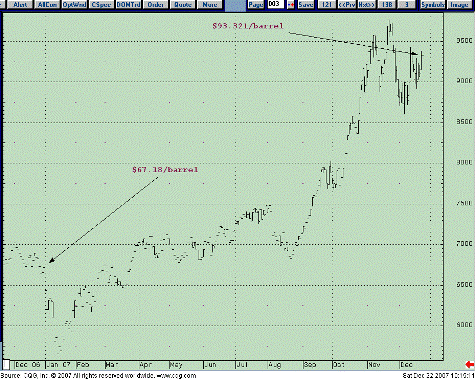
Source: Commodity.com
The International Energy Agency (IEA) recently increased its estimate of 2008 world oil demand to 87.8 million barrels per day (MPDA). According to T. Boone Pickens, world production capacity tops out at 86.0 MPDA.
Is a recession coming? Perhaps, but recessions in the past haven't appreciably decreased energy demand since this demand is somewhat inelastic. My best guess is oil will remain firm in 2008, but because of the raw price appreciation in 2007, it won't necessarily make the 2008 top performer list.
However, here's one prediction for you: $100-a-barrel oil (sometime early in 2008), here we come.
No. 2--Soybeans
- Close on 12/29/06= $7.43 per bushel
- Close on12/21/07= $11.78 per bushel
- Percent change in 2007= 59 percent
January Soybeans
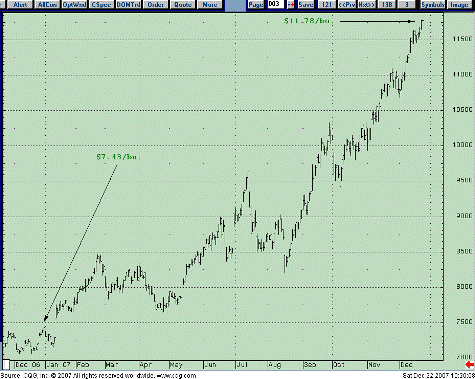
Source: Commodity.com
On Dec. 21, soybeans closed at a new 34-year high. In just the first quarter of the marketing year for soybeans--the marketing year runs from September to September--the US has already sold 65 percent of the country's annual target for soybean sales. As long as China continues to buy soybeans at a record rate, this market should remain strong.
How high is too high? It depends on how big the newly planted South American crop will turn out. If it's big, the market could top out shortly. If there are any weather problems in that part of the world into early next year, there's no way of telling how high is really high.Next year acreage is projected to be up, but demand should also reach a new record high. Future price predictions here are tough, so we'll need to go with the flow.
No. 1---Minneapolis Wheat
- Close on 12/29/06= $5.06 per bushel
- Close on 12/21/07= $10.78 per bushel
- Percent change in 2007= 113 percent
March Minneapolis Wheat
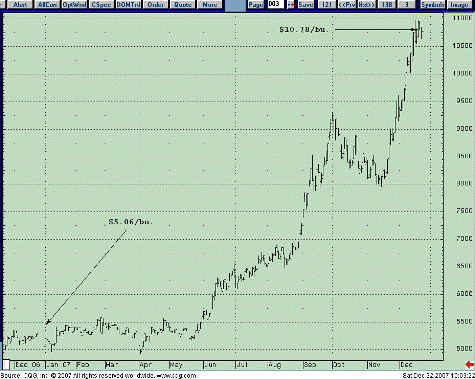
Source: Commodity.com
Wheat ending stocks are at a 60-year low because of poor crops this year in Australia, Canada and the Ukraine. US wheat exports are up 66 percent versus a year ago, and the US has already sold 90 percent of its annual target for wheat sales. The supplies of the Minneapolis wheat variety, spring wheat, are particularly tight because of sharply lower planted acreage this year.
Incredibly, more corn acreage was planted in North Dakota than spring wheat. This has never happened before and probably won't happen again. With these record-high wheat prices, it's no surprise the planted acreage for next year's wheat crop is sharply higher.
Will wheat be one of the 2008 top performers? My vote is no.
Bottom Commodity Performers
No. 4--Coffee
- Close on 12/29/06= $1.41 per pound
- Close on 12/21/07= $1.34 per pound
- Percent change in 2007= Down 5 percent
Commodities aren't all created equal. Coffee prices actually lost 5 percent in 2007.
What's the best estimate for 2008? Assuming normal growing weather in the coffee growing regions of the world (South America, Asia and Africa), coffee will still move back into the plus column, but not necessarily the top tier.
Weather problems? Numbers will be much higher if the answer to this question is yes.
No. 3--Sugar
- Close on 12/29/06= 12.02 cents per pound
- Close on 12/21/07= 11.05 cents per pound
- Percent change in 2007= Down 8.1 percent
2006-07 Sugar
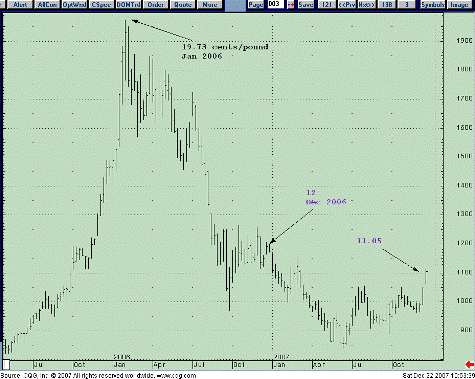
Source: Commodity.com
This is one of Jim Rogers' favorites. However, a whole host of markets, including the world's stock markets, fared much better than sugar in 2007. Sugar was also a poor performer in 2006, down 41 percent last year. To be fair, Rogers has been bullish on sugar for years, and it was the top performer for 2005 (up a remarkable 227 percent).
This coming year? At historically cheap prices with the major trend turning up, my best guesstimate is sugar will be solidly in the plus column by the end of 2008.
No. 2--Hogs
- Close on 12/29/06= 66 cents per pound
- Close on12/21/07= 59.7 cents per pound
- Percent change in 2007= Down 9.5 percent
Because of poor profit margins and record high numbers, the hog market fared poorly in 2007. However, the hog cycle is about six months long, and when producers are squeezed, they traditionally adjust by cutting production. With feed prices high, the squeeze continues and numbers should be much smaller in 2008, along with the associated higher prices.
A top performer in 2008? Not necessarily, but my vote for the hog market next year is a standing in the plus column.
No. 1--Orange Juice
- Close on 12/29/06 $2.01 per pound
- Close on 12/21/07 $1.49 per pound
- Percent change in 2007= Down 26 percent
2006-07 Orange Juice
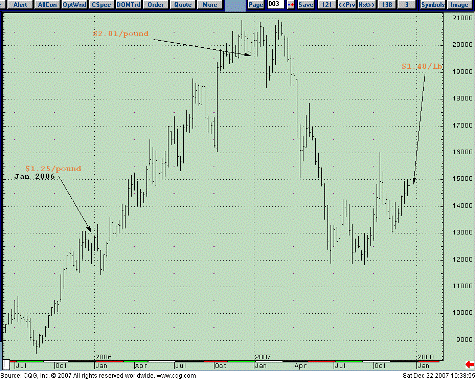
Source: Commodity.com
One of the best performers for 2006 up 161 percent, orange juice took the cake for the worst spot in 2007. And the outlook for this coming year? When it comes to orange juice, your guess is as good a mine.
Here's wishing you a very happy holiday season and a very prosperous new year.
By George Kleinman
President
Commodity Resource Corp.
Lake Tahoe,
Nevada 89452-8700
http://www.commodity.com
George Kleinman is the President of the successful futures advisory and trading firm Commodity Resource Corp. (CRC). George founded CRC in 1983 while on the "floor" of the Minneapolis Grain Exchange to offer a more personalized level of service to traders. George has been an Exchange member for over 25 years. George entered the business with Merrill Lynch Commodities (1978 - 1983). At Merrill he attained the honor of 'Golden Circle' one of Merrill's top ten commodity brokers internationally. He is a graduate of The Ohio State University with an MBA from Hofstra University. George has developed his own proprietary trading techniques and is the author of three books on commodity futures trading published by the Financial Times.
He is Executive Editor of Futures Market Forecaster, a KCI Financial publication. In 1995, George relocated CRC to Nevada and today trades from an office overlooking beautiful Lake Tahoe. The firm assists individuals and corporate clients. CRC¹s exclusive clearing firm is R.J. O'Brien with all client funds held at RJO (assets in excess of $1.9 billion). Founded in 1914, R.J. O'Brien is a privately owned Futures Commission Merchant, and one of the most respected independent futures brokerage firms in the industry. RJO is a founding member of the Chicago Mercantile Exchange, a full clearing member of the Chicago Board of Trade, New York Mercantile Exchange, Commodity Exchange of New York and the New York Board of Trade. RJO offers the latest in order entry technology coupled with 24-hour execution and clearing on every major futures exchange worldwide. There is risk of loss when trading commodity futures and this asset class is not appropriate for all investors.
Risk Disclaimer
Futures and futures options can entail a high degree of risk and are not appropriate for all investors. Commodities Trends is strictly the opinion of its writer. Use it as a valuable tool, not the "Holy Grail." Any actions taken by readers are for their own account and risk. Information is obtained from sources believed reliable, but is in no way guaranteed. The author may have positions in the markets mentioned including at times positions contrary to the advice quoted herein. Opinions, market data and recommendations are subject to change at any time. Past Results Are Not Necessarily Indicative of Future Results.
Hypothetical Performance
Hypothetical performance results have many inherent limitations, some of which are described below. No representation is being made that any account will or is likely to achieve profits or losses similar to those shown. In fact, there are frequently sharp differences between hypothetical performance results and the actual results subsequently achieved by any particular trading program. One of the limitations of hypothetical performance results is that they are generally prepared with the benefit of hindsight. In addition, hypothetical trading does not involve financial risk, and no hypothetical trading record can completely account for the impact of financial risk in actual trading. For example, the ability to withstand losses or to adhere to a particular trading program in spite of trading losses are material points which can also adversely affect actual trading results. There are numerous other factors related to the markets in general or to the implementation of any specific trading program which cannot be fully accounted for in the preparation of hypothetical performance results and all of which can adversely affect actual trading results.
George Kleinman Archive |
© 2005-2022 http://www.MarketOracle.co.uk - The Market Oracle is a FREE Daily Financial Markets Analysis & Forecasting online publication.



